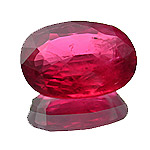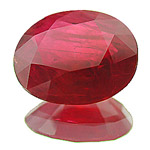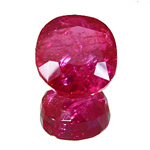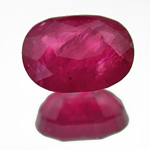Glass-filled Ruby
AGL (American Gemological Laboratories) und GRS (GemResearch Swisslab) agree on nomenclature for glassfilled rubies.



Background
In 2003 the first glass-filled rubies appeared on the international gem markets. The raw material for these stones is low-grade ruby (so low-grade that the term "corundum" is actually more applicable) from East Africa.
By filling cracks and fissures with lead-glass, transparency as well as saleability are enhanced dramatically.
Since then so many glass-filled rubies have hit the market, one can justifiably call it a flood.
Identification
Detection is in most cases rather simple for a trained person. When viewed through the 10x loupe in good light, tell-tale bluish and/or orangish flashes of light as well as gas bubbles are a sure sign of glass fillings. Besides there is a difference in luster between glass and ruby, which can be observed in places where the glass reaches the surface.
Problems
Apart from the fact that dubious sellers do not (or wrongly or incompletely) disclose the treatment and thus mislead (deceive? cheat?) the customer, the main problem is the very low durability.
Leadglass is highly susceptible to acids and solvents. The goldsmith´s pickling solution and even quite mild acids like lemon juice suffice to damage the glass filler and thoroughly alter the visual appearance of the ruby.
Rather soon after their appearrance it was established that the glass-content of these stones is very high, indeed, and can reach 75% (!!) in some cases. In fact many, if not most, contain more glass than ruby.
As early as 2007 the American Gemological Laboratories (AGL) started to use the term "Composite Ruby" for these stones. Dr. Peretti´s GemResearch Swisslab (GRS) followed suite in 2010 with the term "Hybrid Ruby".
For some time it was discussed, whether it makes sense to introduce different levels of treatment according to the different glass-contents. Much to our satisfaction the idea was dropped. After all, customers at the retail level do not care, whether the glass content is 75% or "merely" 35%. Most people shy away - and rightly so! - and refrain from buying when they learn that the ruby of their desire is glass-filled, whatever the percentage.
Since October 3rd, 2011 GRS and AGL laboratory reports read as follows:
GRS
Synthetic* Glass/Treated Ruby (GRS-type “Hybrid Ruby”)
Comments: Heat-treated and filled with a colored foreign solid substance (including lead). Special care required when handling. Also known as Composite Ruby.
*note: the term "synthetic" may be misleading. In our opinion it refers to the man-made nature of the glass rather than the ruby, which is of natural origin
AGLComposite Ruby
Comments: This stone is a composite of natural ruby and a high lead content glass. Also known as Hybrid Ruby.*
*See Enhancements section of the AGL report for additional comments related to the durability and special care of this product.
Our Position
We of the Vienna Gem center consider the practice to be non-ethical and a violation of the gemtrade´s code of conduct, even if disclosed at the point of sale.
We hope that all gemlabs will start to apply this nomenclature and we fall in line with Dr. Peretti´s statement that ''Most of these stones are so heavily in-fused with lead-glass that many believe they should not even be associated with the name of ruby.''
 Deutsch
Deutsch